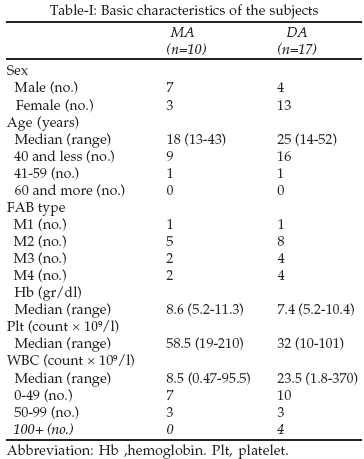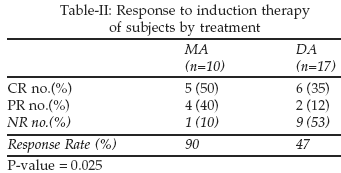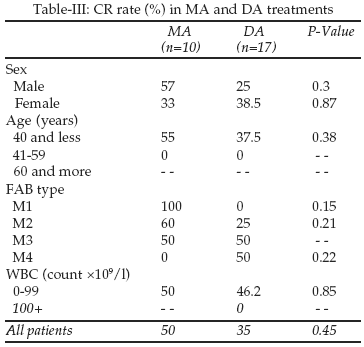|
|
||||
|
Published by : PROFESSIONAL MEDICAL PUBLICATIONS |
||||
|
ISSN 1681-715X |
||||
|
||||
|
- |
||||
|
ORIGINAL ARTICLE |
||||
|
- |
||||
|
Volume 23 |
October - December 2007 (Part-II) |
Number 6 |
||
|
|
||||
|
|
||||
|
|
||||
|
Published by : PROFESSIONAL MEDICAL PUBLICATIONS |
||||
|
ISSN 1681-715X |
||||
|
||||
|
- |
||||
|
ORIGINAL ARTICLE |
||||
|
- |
||||
|
Volume 23 |
October - December 2007 (Part-II) |
Number 6 |
||
|
|
||||
|
|
||||
Mitoxantrone plus cytarabine versus daunorubicin
plus cytarabine as induction therapy for previously
untreated adult patients with acute myeloid leukemia
Alireza Nikanfar1, Iraj Asvadi2, Jalil Vaez3
ABSTRACT
Objective: The aim of this study was to evaluate the efficacy of mitoxantrone versus daunorubicin on the response rates of acute myeloid leukemia (AML) patients.
Methodology: In this prospective randomized trial, adult patients with newly diagnosed AML received daunorubicin(45mg/m²/d for 3 days) or mitoxantrone (12mg/m²/d for 3 days), each combined with the identical dose of cytarabine(ara-c) (150mg/m²/d by continuous infusion for 7 days). Of 27 patients, 10 were randomly allocated to the mitoxantrone plus ara-c "MA" treatment arm and 17 to the daunorubicin plus ara-c "DA" treatment arm.
Results: Median age of the patients in MA was18 years and in DA was 25. Fifty percent of the MA achieved complete remission and 40% achieved a partial remission giving an overall response rate of %90. The same overall response rate was significantly lower in DA group (P=0.025).
Conclusion: The combination of mitoxantrone and ara-c is a possible alternative to daunorubicin and ara-c combination for the treatment of AML.
KEY WORDS: Mitoxantrone, Cytarabine, AML.
Pak J Med Sci October - December 2007 (Part-II) Vol. 23 No. 6 909-912
1. Dr. Alireza Nikanfar,
Assistant Professor of Internal Medicine,
2. Dr. Iraj Asvadi,
Professor of Internal Medicine,
3. Dr. Jalil Vaez,
Professor of Internal Medicine,
1-3: Hematologist & Oncologist,
Hematology & Oncology Research Center,
Tabriz University of Medical Sciences. Tabriz – Iran.
Correspondence
Dr. Alireza Nikanfar,
Email: Nikanfarar@hotmail.com;
horc_tums@yahoo.com
* Received for Publication: April 30, 2007
* Revision Accepted: August 12, 2007
INTRODUCTION
A combination of anthracycline and cytarabine has been used as the standard induction therapy of AML since 1973. A routine, classic and standard induction regimen (7 and 3 regimen) is now available with cytarabine (100mg/m
2 daily) by continuous infusion on days one through seven and daunorubicin (45mg/m² daily) on days one through day three. A complete remission (CR) rate of 55-90 percent has been reported.1 Most studies of induction therapy of AML have showed that advanced age is the most negatively influencing factor affecting the achievement of CR.2Mitoxantrone is an anthraquinone that has replaced anthracyclines in some cytarabine-containing induction regimens. Early studies suggested that mitoxantrone might be better tolerated causing less alopecia, gastrointestinal toxicity, and possibly, less cardiac toxicity compared to anthracyclines.
3-5 It has been used more often at relapse and in the elderly.3,5-7The aim of this study was to evaluate the efficacy of mitoxantrone versus daunorubicin on the response rates of AML patients.
PATIENTS AND METHODS
In this prospective randomized trial, adult patients with newly diagnosed AML received daunorubicin or mitoxantrone, each combined with the identical dose of cytarabine.
Eligibility: Adult patients under the age of 60 with a morphologically confirmed diagnosis of previously untreated AML by French-American-British (FAB) criteria were eligible. Most of the patients had flowcytometric immunophenotype confirmation of the diagnosis, but cytogenetic study was not available. Patients with secondary AML were excluded. They should have had a performance status of 0-2 defined by World Health Organization. Required initial laboratory data included creatinine and serum bilirubin levels less than 1.5 time the upper limits of the normal.
A normal left ventricular ejection fraction assessed with echocardiography was required. Subjects with cardiovascular disease including recent (less than 6 months) myocardial infarction and those with any active bacterial, viral and fungal infections were excluded.
Study Design:
Patients were randomly assigned to one of two remission induction treatment arms:1. (MA) cytarabine 150mg/m2 daily for 24 hour continuous intravenous infusion on days one through day seven and mitoxantrone 12mg/m2 intravenous daily on days one through day three.
2. (DA) cytarabine as the same as (MA) arm plus daunorubicin 45mg/m2 intravenous daily on days one through day three.
A bone marrow aspirate was obtained on day 14. If the marrow showed five percent or more blasts, a second cycle of induction chemotherapy was administered. The dose of drugs administered for cycle two was the same as cycle one. Response to remission induction therapy was evaluated according to the criteria defined in a workshop sponsored by the National Cancer Institute.
3 CR was defined as the normalization of neutrophil counts (at least 1.5 ×109/L) and platelet counts (>100× 109/L) and a marrow aspirate and biopsy showing at least 20% cellularity, less than five percent blasts and no Auer rods as well as absence of extramedullary leukemia. Partial remission defined by 5 to 25 percent blasts.Statistical Methods: Descriptive statistics using SPSS11 soft ware were calculated to document the response rates. Two proportions Z-test was used to compare response rates between two groups of subjects received MA and DA treatment protocols. P-values = 0.05 or less was considered significant.
RESULTS
A total of 29 patients were recruited for this study. Two patients, one from each treatment arm, were excluded because of early death. Of 27 remaining subjects, 10 were randomly allocated to the MA treatment arm and 17 to the DA treatment arm. Patients and disease characteristics of the subjects is presented in Table-I. Two groups of patients were almost similar. The study sample comprised seven males and three females in MA group with median (range) age of 18 (13-43). The same figures were four males and 13 females with median (range) of 25 (14-52) in DA group.

Table-II shows the response rates to induction therapy of subjects by treatment. As seen in the table, five (50 percent) of the MA group achieved CR and four (40 percent) achieved a PR giving an overall response rate (CR+PR) of 90 percent. The same overall response rate was significantly lower in DA group (P=0.025).

Responses to induction chemotherapy by selected clinical and disease characteristics are shown in (Table-III). There was no statistical significant difference between two groups in terms of any of gender, age, FAB types and white blood cell (WBC) count.

DISCUSSION
Mitoxantrone is a synthetic anthraquinone that has been used for several years in the treatment of AML. Its use has been based on its incomplete cross-resistance with other intercalating agents, and its better tolerance.
8 In combination with cytarabine, mitoxantrone has been found to be effective in the treatment of refractory and relapsed AML.9 The present study was designed to compare the efficacy of this less toxic and well tolerated drug to daunorubicin as induction therapy in the newly diagnosed adult patients with AML under the age of 60. Higher CR rate with MA versus DA regimen (50% compared to 35%) in this study was not significant (P=0.45), but overall response rate (CR+PR) in MA group was significantly brtter than DA group (P=0.025). The limitation of trial was the small number of cases and the absence of cytogenetic study.Mitoxantrone has been used more often in the elderly.
5,10,11 In one study a regimen of mitoxantrone(10mg/m² for 4 days) and cytarabine (100 mg/m² twice daily for 5 days)was evaluated as first line therapy in elderly patients (>60 years) with AML. Of 86 cases with de-novo AML, 64% achieved CR and 6% achieved PR giving an overall response rate of 70%.5Another group treated 33 older patients (>59 years)with newly diagnosed AML ,with mitoxantrone (12mg/m²/d for 3 days or 10 mg/m²/d for 5 days) and cytarabine (100mg/m² twice daily for 7 days) and observed 48% CR rates.
10 In another study, in AML in the elderly, cytarabine was administered at a dose of 100mg/m² for 7 days and combined with either mitoxantrone 8mg/m² or daunomycine 30mg/m² daily for 3 days. A significantly higher CR (P=0.069) was observed with mitoxantrone (47% compared with 38%).11Limited trials reported high CR with mitoxantrone and cytarabime in newly diagnosed AML patients without direct comparison with daunorubicin.
12-14 In another research 29 patients with newly diagnosed AMLwere treated with mitoxantrone and cytarabine in the same dose as in the present study and 83% CR rate was reported.12In one study in Kuwait 21 patients with previously untreated AML were treated, with sequential mitoxantrone and standard dose cytararbine and 80% CR rate was observed.
13In yet another study in Turkey a trial was conducted to evaluate the impact of mode of administration of mitoxantrone in combination with standard dose cytarabine on the response rates in 40 newly diagnosed patients with AML and observed 75% and 80% CR rates in the bolus and continuous infusion arms, respectively.
14In a study of similar design to the present study, authors compared DA with MA regimen in the same dose and schedule as in the present study. Because there were no significant differences between MA and DA regimen with respect to CR rate (63% compared to 53%), survival or toxicity, the investigators concluded that MA and DA were comparable in the first line treatment of patients with AML. However, in that study patients treated with MA were more likely to achieve CR with one induction course than were patients treated with DA.
15 In another study with similar design , investigators demonstrated similar incidence of CR with MA and DA regimen(53%compared with 43%).16 Higher CR rate with MA versus DA in this study is similar to that reported in other trials.We conclude that the combination of mitoxantrone and cytarabine is a possible alternative to daunorubicin and cytarabine combination for the treatment of AML.
ACKNOWLEDGEMENTS
We thank Dr. Saeed Dastgiri for critically reviewing the study protocol and analyzing the data.
REFERENCES
1. Liesveld JL, Lichtman MA. Acute myelogenous leukemia, ‘Williams Hematology’ (7th ed ) (vol.1), Lichtman MA, Beutler E, Kipps TJ, (Eds), In: McGraw-Hill Medical publishing Division, New York. 2006;1183-211.
2. Wiernik PH, Banks PL, Case DC Jr, Arlin ZA, Periman PO, Todd MB, et al. Cytarabine plus idarubicin or daunorubicin as induction and consolidation therapy for previously untreated adult patients with acute myeloid leukemia. Blood 1992;79(2):313-9.
3. Greer JP, Baer MR, Kinney MC. Acute myeloid leukemia in adults, ‘Wintrobe’s clinical Hematology’ (11th ed ), Greer JP, Foerster JN, Lukens J, Rodgers GM, Paraskevas F, Glader B (Eds), Lippincott Williams & Wilkins Philadelphia 2004;2097-142.
4. Anderson J, Kopecky K, Willman C, Head D, O’Donnel M, Luthardt F, et al. Outcome after induction chemotherapy for older patients with acute myeloid leukemia is not improved with miotozanfrome and etoposide compared to cytarabine and daunorubicin. Blood 2002;100:3869-76.
5. Yin JAL, Johnson PRE, Daview JM, Flanagan NG, Grost DW, Lewis MJ. Mitoxantrone and cytosine arabinoside as first-line therapy in elderly patients with acute myeloid leukemia. Br J Haematol 1991;79:415-20.
6. Dalley CD, Lillington DL, Bradburn M, Carter M, Amess JA, Rohatiner AZ, et al. Acute myelogenous leukemia in older patients at st Bartholom ew’s Hospital: outcome with mitoxantrone and cytarabine. Hematol J 2002;3(5):237-43.
7. Paciucci PA, Cuttner J, Holland JF. Sequential intermediate dose cytosine arabinoside and mitoxantrone for patients with relapsed and refractory acute myelocitic leukemia. Am J Hematol 1990;35:22-5.
8. Thomas X, Archimbaud E. Mitoxantrone in the treatment of acute myelogenous leukemia: a review. Hematol Cell Ther 1997;39(4):63-74.
9. Sternberg DW, Aird W, Neuberg D, Thompson L, MacNevill K, Amrein P, et al. In: Teatment of patients with recurrent and primary refractory acute myelogenous leukemia using mitoxantrone and intermediate-dose cytarabine. Cancer 2000;88(9):2037-41.
10. MaCallum PK, Rohatiner AZ, Davis CL, Whelan JS, Oza AM, Lim J, et al. Mitoxantrone and cytosine arabinoside as treatment for acute myeloblastic leukemia in older patients. Ann Hematol 1995;71:35-9.
11. Lowenberg B, Suciu S, Archimbaud E, Haak H, Stryckmans P, de cataldo R, et al. Mitoxantrone versus daunorubicin in induction-consolidation chemotherapy -the value of low-dose cytarabine for maintenance of remission, and an assessment of prognostic factors in acute myeloid leukemia in the elderly. J Clin Oncol 1998;16(3):872-8.
12. Paciucci PA, Cuttner J, Gottlieb A, Davis RB, Martelo O, Holland JE. Sequential mitoxantrone daunorubicin and cytosine arabinoside for patients with newly diagnosed acute myelocytic leukemia. Am J Hematol 1997;56:214-8.
13. Al Bahar S, Pandita R, Bavishi K, Savani B. Sequential standard dose mitoxantrone and cytosine arabinoside for newly diagnosed adult acute myeloblastic leukemia. Neoplasma 1999;46:61-5.
14. Koc Y, Oyan B, Kars A, Tekuzman G, Canpinar H, Kansu E. A randomized trial of continuous infusion versus bolus mitoxantrone in combination with cytarabine in newly diagnosed patients with acute myeloblastic leukemia. Hematol Oncol 2004;22:43-53.
15. Arlin ZA, Case DC Jr, Moor J, Wiernik P, Feldaman E, Saletan S, et al. Randomized multicenter trial of cytosine arabinoside with mitoxantrone or daunorubicin in previously untreated adult patients with acute nonlymphocytic leukemia(ANLL). Leukemia, 1990;4:177-83.
16. Pavlovsky S, Gonzalez Llaren J, Garsia Martinez MA, Sobrevilla P, Eppinger-Helft M, Marin A, et al. A randomized study of mitoxantrone plus cytarabine versus daunomycin plus cytarabine in the treatment of previously untreated adult patients with acute non lymphocytic leukemia. Ann Hematol 1994;69:11-5.
HOME | SEARCH | CURRENT ISSUE | PAST ISSUES
Professional
Medical Publications
Room No. 522, 5th Floor, Panorama Centre
Building No. 2, P.O. Box 8766, Saddar, Karachi - Pakistan.
Phones : 5688791, 5689285 Fax : 5689860
pjms@